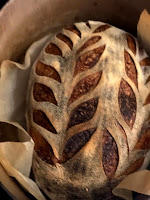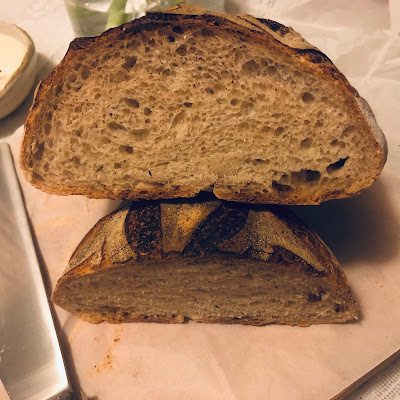A Farmhouse Bread French Style
It is the traditional French classic country sourdough bread or often they say it is a farmhouse sourdough bread. There is good information on Wikipedia about it and it is very interesting.
Today, I am sharing about how to bake this bread, and the formula is based on the International School of Bulangeri in France.
De pain de Campagne
Formula
1 kg flour
200g sourdough starter
750g water
20 salt
(uses specific flour in France)
I modified a little to the Formula
To bake a loaf
420g bread flour
30g wholemeal flour
50g rye flour
100g sourdough starter
375g water
10g salt
The Process
Flour, water, starter, and salt.
Mix all ingredients thoroughly, using hand until you arrive on to a shaggy mass, cover the dough.
Rest to autolyse for three hours. The dough without cover bellow is the dough after 3 hours resting.Followed by giving folds and turns to the dough. The dough is relaxed at this stage and pretty easy to handle, to work with. Let the dough resting for 15 minutes, before the bulk fermentation.
Start the Bulk Fermentation
Giving the dough folds and turns a few times, then rest for 30 minutes. Continue to fold and turn every 30 minutes interval. Do this four times. This process is very enjoyable. After giving the dough folds, turns and rest in between for two hours, now, cover the dough, let the dough have a longer rest undisturbed for 1 hour and 45 minutes.
After this, start preliminary shaping, shape the dough into a boule, handle it gently make sure you do not degus the dough.
 |
| Preliminary Shaping |
 |
| Cover the dough, rest for 25 minutes |
Cover the dough to have the bench rest for 25 minutes (the bench rest)
Now it is time for the final shaping, give the dough gentle exercises, using your hands and the bench knife to pull and push around to make the dough to be strong and taut. Remember that we have to be careful not using the force action, we do not want to tear the dough. Shape into a batard or a boule as you wish.
The Final Shaping
Love these look
Transfer the dough on to the lined banneton which is dusted generously with rice flour and place it - bottom of the dough is side up (on the top). Cover with plastic and retard in the refrigerator overnight. Ready for baking in the morning.
 |
| The is cover with plastic for retard in the fridge |
 |
| The dough sits on the lined banneton with coth |
In The Morning - Baking Day
Set up the oven to 250 degrees C, place the dutch oven in. It takes one hour to reach the temperature.
Before baking, place the dough on a peel lined with parchment paper, now the top dough is sitting in the bottom. Score the dough as you like. Load the dough onto the hot dutch oven (in my case I use my large Le Creuset pot), put the lid on, and bake for 22 minutes. (this is the first step of baking). After finished the tine, take the lid off, and continue baking for 33 minutes until it is dark chestnut brown. Total baking is 55-60 minutes.
Pictures-Baking Pain de campagne

The first 22 minutes of the baking is so important, most baker anxious to wait for the occasion. And here when I saw, a gorgeous looking loaf, marvel the beauty, oh, yes indeed, it's awesome. This is the formation of the bread, what you see right now, is the bread in the final baking, only the color is different.
Fantastic Farmhouse Bread. Pretty and Perfect.
The first time using the Formula of Pain de campagne of the school and worked beautifully. I may have to keep this recipe for family sourdough bread.
The baker shows off the hard labor that she enjoys so much and is very proud. The baking needs one hundred and ten percent concentration, watch out to work with the hot oven at 250 degrees C, putting in and getting out a heavy hot pot. Strong and safe mitten for the oven are essential.
The crust is beautifully crunchy and the crumb is finer compare to the other sourdough bread that I have been baking for the last two months, it is delicious though. The picture was taken at night.
I am glad to learn from this school, in fact, lots of temptation on the baking accessory that would be nice to have.
A lot more to learn from this school: Ecole Internationale de Boulangerie to look forward to.
I think I am getting there, growing to be more confident handling the dough and the process, also no more fear to work with the very hot oven. All of that nake the baking is a success.
Attach bellow is about Pain de campagne, enjoy and happy reading.
Pain de campagne
Wikipedia
Pain de campagne ('country bread' in French), also called "French sourdough", is typically a large round loaf ('miche') made from either natural leavening or baker's yeast. Most traditional versions of this bread are made with a combination of white flour with whole wheat flour and/or rye flour, water, leavening, and salt. For centuries, French village had communal ovens where the townsfolk would bring their dough to be baked, and the loaves weighed from four to as much as twelve pounds (1.5-5.5 kg). Such large loaves would feed a family for days or weeks, until the next baking day.
Before the advent of roller milling, virtually all wheat was milled by stone grinding. In order to produce a lighter, less chewy bread, the whole wheat flour was sifted or bolted using mesh or cloth. This resulted in a whiter flour that still retained some of the bran and germ. The addition of rye flour in some recipes probably originates from the presence of rye growing among the wheat. All the grain was harvested together, and as much as 10 percent of it would be rye. Rey flour ferments more quickly than wheat flour, and it imparts a distinctive flavor to traditional pains de campagne.
With the rise of commercial yeast at the turn of the 20th century, pain de campagne fell out of favor in French cities, where it was replaced by the baguette. However, with the rise of artisan bread in the 1970s, pain de campagne has been growing in popularity, both in Europe and the US.
Today pain de campagne is still made in France and is enjoying a growing appreciation in the United States and the UK. When made traditionally, the dough is allowed to ferment for several hours, allowing the yeasts to grow and develop the flavors. The dough is then rounded and placed in linen-lined baskets called 'bannetons'. After the dough has risen, it is dumped out of the basket and onto a peel and slid into the oven wher3e it bakes at 240 degrees C (450 degrees F) for about one hour.
Until Next Post
Susy


















No comments:
Post a Comment